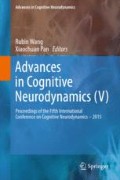Abstract
There is an unsettled debate in neuroscience on the question of neural processes underlying impressions of causality. Some favor perceptual (bottom-up), others cognitive/inferential (top-down) approaches. We here try to disentangle and apply new definitions to the functional categories “cognition” and “perception,” based on anatomically distinct neural processing systems in the human brain. Especially, the perceptual domain is not well defined, because it spans across “sensory”/morphological domains (non-lateralized) to “higher perceptual” domains (crossing of hemispheres in the visual cortex and correspondingly in the visual domain). Top-down influences very likely occur at different stages of neural information processing. Corresponding mental functions (sensing, perceiving, interpreting) might be integrated into one type of event during meaningful (meta-)cognition with extreme ends of the information dimension (0/1, causal/noncausal, or even/odd). We suggest that top-down “causation” and bottom-up “agency” are complimentary processes interacting across functional modalities and thereby forming one “unit” of explicit conscious experience/one “momentum” (Michotte in The perception of causality. Basic Books, Oxford, 1963 [1]; Kant in Kritik der reinen Vernunft. Suhrkamp Verlag, Frankfurt am Main, 1781 [2]).
Access this chapter
Tax calculation will be finalised at checkout
Purchases are for personal use only
References
Michotte, A.: The Perception of Causality. Basic Books, Oxford (1963)
Kant, I.: Kritik der reinen Vernunft (1781). In: von Weischedel, W. (ed.), Suhrkamp Verlag, Frankfurt am Main (1974)
Schlottmann, A., Shanks, D.R.: Evidence for a distinction between judged and perceived causality. Q. J. Exp. Psychol. A 44, 321–342 (1992)
Badler, J.B., Lefevre, P., Missal, M.: Divergence between oculomotor and perceptual causality. J. Vis. 3, 1–15 (2012)
Badler, J.B., Lefevre, P., Missal, M.: Causality attribution biases oculomotor responses. J. Neurosci. 31, 517–525 (2010)
Blakemore, S.J., et al.: The detection of contingency and animacy from simple animations in the human brain. Cereb. Cortex 13, 837–844 (2003)
Adams, R.A., Shipp, S., Friston, K.J.: Predictions not commands: active inference in the motor system. Brain Struct Funct 218, 611–643 (2013)
Roser, M.E., et al.: Dissociating processes supporting causal perception and causal inference in the brain. Neuropsychology, 591–602 (2005)
Fonlupt, P.: Perception and judgement of physical causality involve different brain structures. Brain Res. Cogn. Brain Res. 17, 248–254 (2003)
Gobbini, M.I., et al.: Distinct neural systems involved in agency and animacy detection. J. Cogn. Neurosci. 23(8), 1911–1920 (2011)
Young, M.E., Rogers, E.T., Beckmann, J.S.: Causal impressions: predicting when, not just whether. Mem Cogn 33, 320–331 (2005)
Straube, B., Chatterjee, A.: Space and time in perceptual causality. Front Hum Neurosci 4, 28 (2010)
Wende, K.C., Straube, B., Stratmann, M., Sommer, J., Kircher, T., Nagels, A.: Neural correlates of continuous causal word generation. Neuroimage 62, 1399–1407 (2012)
White, P.A.: The causal asymmetry. Psychol. Rev. 113, 132–147 (2006)
Choi, H., Scholl, B.J.: Measuring causal perception: connections to representational momentum? Acta Psychol. 123, 91–111 (2006)
Sartenaer, O.: Neither metaphysical dichotomy nor pure identity. Clarifying the emergentist creed. Stud. Hist. Philos. Biol. Biomed. Sci. 44(365), 373 (2013)
Acheson, D.J., Hamidi, M., Binder, J.R., Postle, B.R.: A common neural substrate for language production and verbal working memory. J. Cogn. Neurosci. 23, 1358–1367 (2011)
Crow, T.J.: Schizophrenia as the price that Homo sapiens pays for language: a resolution of the central paradox in the origin of the species. Brain Res. Rev. 4, 118–129 (2000)
Crow, T.J.: The ʻbig bang’ theory of the origin of psychosis and the faculty of language. Schizophr. Res. 102, 31–52 (2008)
Fletcher, P.C., Frith, C.D.: Perceiving is believing: a Bayesian approach to explaining the positive symptoms of schizophrenia. Nat. Rev. Neurosci. 10, 48–58 (2009)
Adams, R.A., Perrinet, L.U., Friston, K.: Smooth pursuit and visual occlusion: active inference and oculomotor control in schizophrenia. PLoS One, United States, p. e47502 (2012)
Sterzer, P., Kleinschmidt, A.: A neural basis for inference in perceptual ambiguity. Proc. Natl. Acad. Sci. USA 104(1), 323–328 (2007)
Piaget, J.: The Child’s Conception of Physical Causality. Harcourt, Brace, New York (1930)
Freeman, W.J.: Consciousness, intentionality, and causality. J. Conscious. Stud. 6, 143–172 (1999)
Freeman, W.J.: Mass Action in the Nervous System. Academic press, New York (1975). san 28
Wende, K.C., Nagels, A., Blos, J., Stratmann, M., Chatterjee, A., Kircher, T., Straube, B.: Differences and communalities in the judgment of causality in a physical and social context: an fMRI study. Neuropsychologia 51, 2572–2580 (2013)
Jansen, A., Foel, A., Van Randenborgh, J., Konrad, C., Rotte, M., Forster, A.F., Deppe, M., Knecht, S.: Crossed cerebro-cerebellar language dominance. Hum. Brain Mapp. 24, 165–172 (2005)
Singer, T., Critchley, H.D., Preuschoff, K.: A common role of insula in feelings, empathy and uncertainty. Trends Cogn. Sci. 8, 334–340 (2009)
Craig, A.D.: How do you feel–now? The anterior insula and human awareness. Nat. Rev. Neurosci. 10, 59–70 (2009)
MacDonald, J.F., Jackson, M.F., Beazely, M.A.: Hippocampal long-term synaptic plasticity and signal amplification of NMDA receptors. Crit. Rev. Neurobiol. 18(1–2), 71–84 (2006)
Trehub, A.: Space, self, and the theater of consciousness. Conscious. Cogn, 310–330 (2007)
Blos, J., et al.: Neural correlates of causality judgment in physical and social context-the reversed effects of space and time. Neuroimage, 882–893 (2012)
Binder, J.R., Desai, R.H., Graves, W.W., Conant, L.L.: Where is the semantic system? A critical review and meta-analysis of 120 functional neuroimaging studies. Cereb. Cortex, United States, 2767–2796 (2009)
Friston, K., Schwartenbeck, P., FitzGerald, T., Moutoussis, M., Behrens, T., Dolan, R.J.: The anatomy of choice: dopamine and decision-making. Phil. Trans. R. Soc. B 369, 20130481 (2014). doi:10.1098/rstb.2013.0481
Author information
Authors and Affiliations
Corresponding author
Editor information
Editors and Affiliations
Rights and permissions
Copyright information
© 2016 Springer Science+Business Media Singapore
About this paper
Cite this paper
Wende, K.C., Jansen, A. (2016). Top-down and/or Bottom-up Causality: The Notion of Relatedness in the Human Brain. In: Wang, R., Pan, X. (eds) Advances in Cognitive Neurodynamics (V). Advances in Cognitive Neurodynamics. Springer, Singapore. https://doi.org/10.1007/978-981-10-0207-6_24
Download citation
DOI: https://doi.org/10.1007/978-981-10-0207-6_24
Published:
Publisher Name: Springer, Singapore
Print ISBN: 978-981-10-0205-2
Online ISBN: 978-981-10-0207-6
eBook Packages: Biomedical and Life SciencesBiomedical and Life Sciences (R0)

